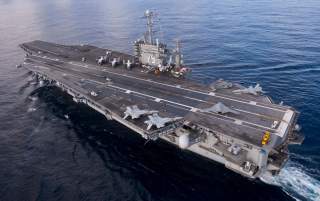Why It Is so Hard to Sink an American Super Aircraft Carrier
Tough ships.
Key point: Beijing might boast about how it can threaten Washington's carriers, but they are hard to sink. In fact, a 2005 test done by the Navy showed how hard it is to take out a carrier.
A Chinese admiral and pundit told a trade-show audience that Beijing could resolve China's territorial disputes by sinking two U.S. Navy aircraft carriers and killing thousands of American sailors.
(This first appeared in 2019.)
Rear Adm. Lou Yuan's threat isn't an empty one. The Chinese military has deployed an array of weaponry that it acquired specifically to target American flattops.
But a U.S. Navy test in 2005 proved that even if you hit them, carriers are really hard to sink.
Lou made his provocative comment on Dec. 20, 2018 at the Military Industry List summit, according to media reports.
“What the United States fears the most is taking casualties,” declared Lou, an anti-American author, social commentator and military theorist at the PLA Academy of Military Science.
Sinking just one carrier could kill 5,000 Americans, Lou pointed out. Sink two, and you double the toll. "We’ll see how frightened America is" after losing 10,000 sailors, Lou crowed.
Leaving aside the likelihood of a full-scale war breaking out between the world's two leading military powers and economies, sinking a carrier is easier said than done. History underscores the difficulty of the undertaking.
In 1964 Viet Cong saboteurs managed to damage and briefly sink the former U.S. Navy escort carrier Card while the vessel, then operating as an aircraft ferry for U.S. Military Sealift Command, moored in Saigon.
But the last time anyone permanently sank a U.S. Navy aircraft carrier in combat was during World War II. Twelve American carriers sank during the war, usually following intensive air attacks. The last to sink, USS Bismarck Sea, fell victim to Japanese kamikazes in February 1945.
In subsequent decades, American flattops suffered serious accidents including collisions and fires, but none sank. It's very difficult to sink a buoyant, thousand-feet-long ship that's mostly made of steel.
The U.S. Navy knows this from experience. In 2005, the Navy itself targeted the decommissioned carrier America in order to determine just how much punishment the vessel could withstand before slipping beneath the waves.
"The ship was pummeled by explosions both above and below the waterline," The War Zone reporter Tyler Rogoway explained in 2018. "After nearly four weeks of these activities, the carrier was scuttled. On May 14, 2005, the vessel's stern disappeared below the waterline and the ship began its voyage to the seafloor."
"America stood up to four weeks of abuse and only succumbed to the sea after demolition teams scuttled the ship on purpose once and for all, it's clear that America was built to sustain heavy damage in combat and still stay afloat."
Consider also the carrier-shaped pontoon ship that Iran built as a scale target for a 2015 war game. While small and flimsy compared to a real flattop, the pontoon vessel itself endured an intensive assault. "Iran struck the faux carrier with a barrage of anti-ship missiles, then swarmed it with small boats and then landed commandos on it," Rogoway reported.
Still, the fake flattop apparently remained afloat.
To even try to sink an American flattop, you first must hit it. That's not easy, either. No carrier sails without an air wing with as many as 50 fighter aircraft plus several escorting destroyers, cruisers and submarines. A virtual wall of defensive weaponry surrounds the flattop out to a distance of several hundred miles.
Still, China or another country could attempt to target the carriers with submarines, cruise missiles and ballistic rockets.
"They will employ multiple systems in order to confuse and overwhelm U.S. defenses," naval historian Robert Farley wrote in 2017. "They will rely on the threat of attack to keep U.S. carrier battle groups as far as possible from the main theaters of operation."
"But the observation that the enemy has a missile or torpedo that can kill a carrier only begins a conversation about carrier vulnerability," Farley continued. "Shooting anything at an aircraft carrier is a costly, difficult operation."
The carrier's attackers could face withering counterfire from the vessel's defenders. "Beyond the monetary cost, launching an open attack against an American carrier strike group, with its own cruisers, destroyers and submarines, is almost certainly a suicide mission."
And if the United States' reaction to the 9/11 terror attacks is any indication, Washington surely would deploy all its remaining military might, including its surviving eight or nine carriers, against country behind the sinking.
"So there are two questions that remain for anyone who thinks they even have a shot at taking down one of these enormous steel behemoths," Farley explained. "Can you do it? And even if you can, is it worth it?"
David Axe serves as the new Defense Editor of the National Interest. He is the author of the graphic novels War Fix, War Is Boring and Machete Squad. This first appeared in 2019.
Image: Reuters

